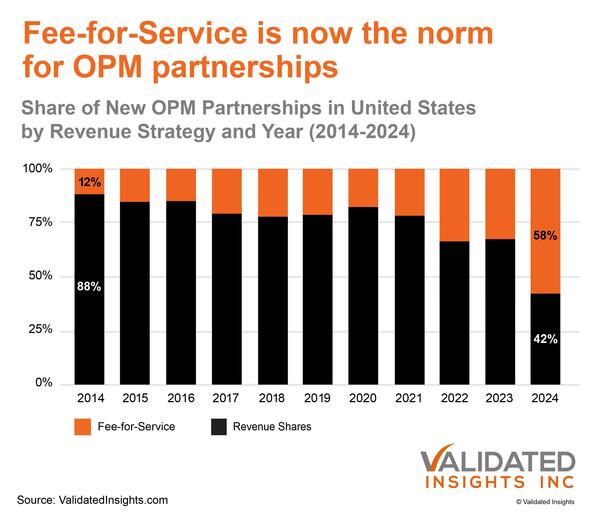Higher Ed Institutions Rely Less on OPMs While Increasingly Hiring Fee-For-Service Models
- Higher education institutions have reduced their reliance on external online program management (OPM) companies, with only 81 new partnerships launched in 2024, a 42% drop from previous years.
- The shift away from OPMs is driven by institutions increasingly adopting fee-for-service models, which offer services à la carte rather than bundled packages.
- Experts criticize revenue-sharing models as predatory arrangements that incentivize aggressive recruiting tactics to increase enrollments and maximize tuition revenue.
- A fee-for-service arrangement allows universities and colleges to pay for specific services, such as marketing or course development, without being tied to a profit split with the OPM company.
IBL News | New York
A market report from Validated Insights released this month notes that fewer colleges and universities hire external online program management (OPM) companies to develop their courses.
For 2024, higher education institutions launched only 81 new partnerships with OPMs — a drop of 42% and the lowest number since 2016.
The report showed that institutions increasingly pay OPMs a fee-for-service instead of following a revenue-sharing model with big service bundles and profit splits.
Experts say revenue-sharing models, which critics denounce as predatory arrangements, incentivize service providers to use aggressive recruiting tactics to increase enrollments and maximize tuition revenue.
According to the report, fee-for-service has become the dominant business model for OPMs.
Under a revenue-sharing agreement, universities and colleges typically receive a bundle of services from an OPM, such as marketing, enrollment, retention services, and course development. Meanwhile, a fee-for-service arrangement offers services à la carte.

• Inside Higher Ed: Fewer Colleges Sharing Profits With OPMs
link
Q. What is the trend observed in the number of new partnerships between higher education institutions and OPMs?
A. The number of new partnerships has dropped by 42% compared to previous years, with only 81 launched for 2024.
Q. When was the lowest number of new partnerships between higher education institutions and OPMs recorded?
A. The lowest number since 2016 was recorded in 2024.
Q. What is the dominant business model for OPMs now?
A. Fee-for-service has become the dominant business model for OPMs.
Q. What are the criticisms of revenue-sharing models used by higher education institutions and OPMs?
A. Critics denounce these arrangements as predatory, which incentivize service providers to use aggressive recruiting tactics to increase enrollments and maximize tuition revenue.
Q. What services typically come with a revenue-sharing agreement between universities and colleges and OPMs?
A. Services such as marketing, enrollment, retention services, and course development are usually included in the bundle.
Q. How do fee-for-service arrangements differ from revenue-sharing agreements?
A. Fee-for-service offers services à la carte, whereas revenue-sharing agreements provide a bundled set of services.
Q. What is the impact of aggressive recruiting tactics on higher education institutions?
A. These tactics can lead to increased enrollments and tuition revenue for OPMs, but may also negatively affect students and institutions.
Q. Why do experts believe that fee-for-service arrangements are becoming more popular?
A. Experts suggest that fee-for-service arrangements offer a more transparent and cost-effective way for institutions to access services from OPMs.
Q. What is the significance of the drop in revenue-sharing agreements between higher education institutions and OPMs?
A. The decline in these agreements may indicate a shift towards more cost-effective and transparent business models in the higher education sector.
Q. How does the trend of fee-for-service arrangements affect the role of OPMs in higher education?
A. As fee-for-service becomes the dominant model, OPMs are likely to focus on providing specific services à la carte rather than offering bundled packages.

